
Iceland is renowned for its spectacular natural beauty, and this is especially evident in the country’s stunning array of waterfalls. From towering cascades to serene plunge pools, Iceland’s 10 most impressive waterfalls offer something unique for every traveler.
For a breathtaking experience, explore some of these incredible sites and take in the power of nature at its finest. This guide will provide insight into the twenty-five most spectacular waterfalls in Iceland and what makes each one so special.
Read Before Visiting: Worst Time To Visit Iceland
Top 25 Iceland Waterfalls
Explore some of the most stunning waterfalls in the world with a trip to Iceland! From thunderous cascades and hidden gems, there is no shortage of incredible waterfalls to discover. Here are our picks for the top 10 Iceland waterfalls that you must visit on your next trip:
1. Skogafoss Waterfall
View Website Get Directions
Location and Size: Skogafoss, one of Iceland’s most magnificent waterfalls, is conveniently located near the Ring Road in the south of Iceland. It stands at an impressive 60 meters high and 25 meters wide, presenting a grand spectacle of nature.
Origins and Name: Believed to be over 1000 years old and created by a glacier, Skogafoss has a unique curved shape. Its name, derived from ‘skogar’ meaning woods in Icelandic, reflects the woodland area surrounding the falls.
Activities and Exploration: The hike to the top of Skogafoss is a rewarding challenge, offering panoramic views of the surrounding landscapes. The climb, though steep and sometimes slippery, is a must-do for adventurous visitors. For those seeking more adventure, there are hidden caves behind the falls, accessible by hiking up steep rocks.
2. Gullfoss Waterfall
View Website Get Directions
Location and Significance: Gullfoss, or “Golden Falls,” is Iceland’s most famous waterfall, forming a key part of the Golden Circle tourist route alongside the Geysir Geothermal Area and Thingvellir National Park.
Magnificent Waterfall Features: The waterfall dramatically drops 32 meters over two tiers into a deep canyon, creating a stunning mist that often forms rainbows in sunlight.
Accessibility and Viewing Experience: A convenient footpath from the car park leads to a viewing platform, allowing visitors to fully experience and appreciate the beauty of Gullfoss.
3. Seljalandsfoss Waterfall
View Website Get Directions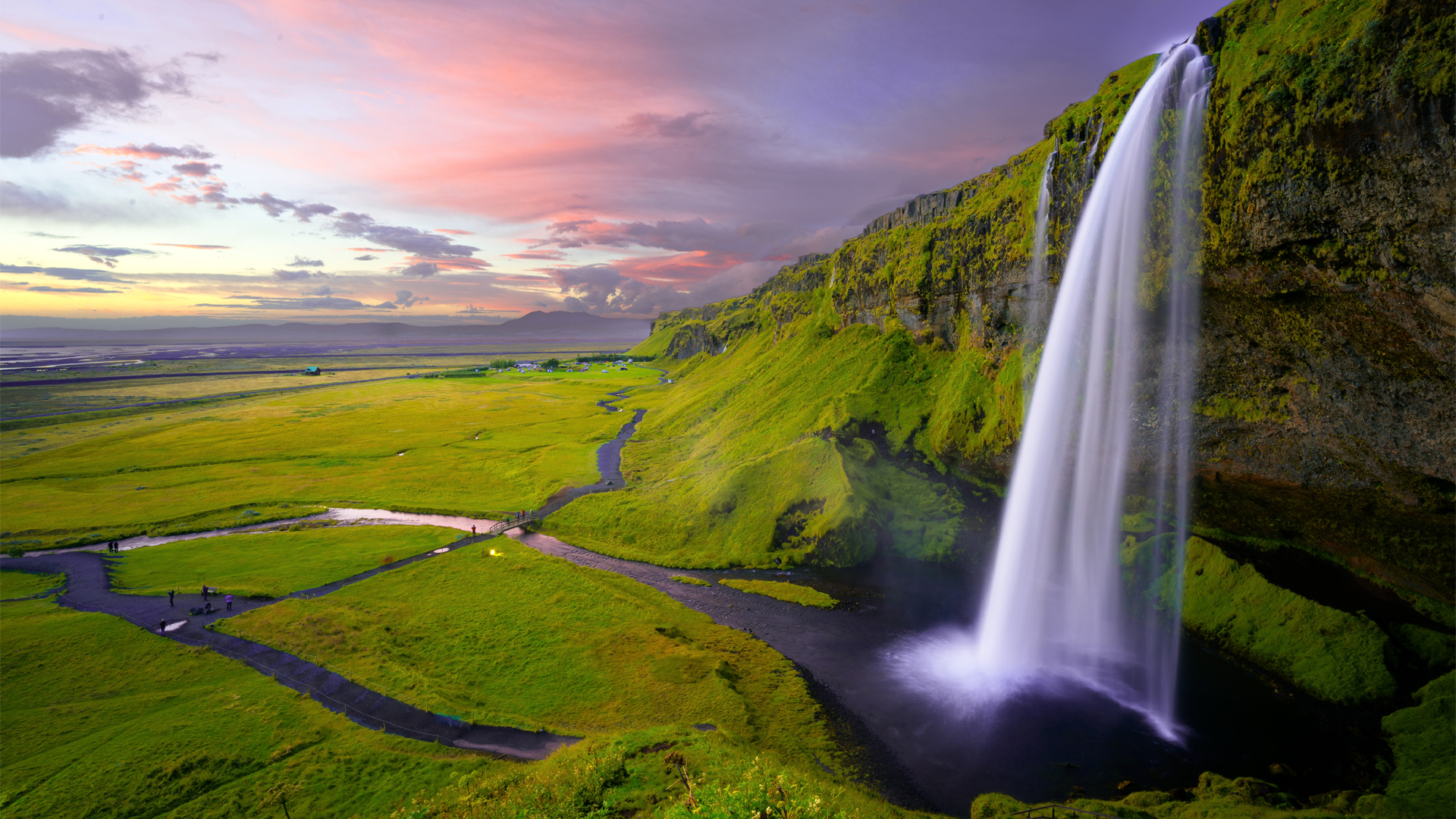
Location and Fame: Seljalandsfoss, situated about 80 miles from Reykjavik in South Iceland, is renowned as one of the most photographed waterfalls in the country.
Unique Features: The waterfall boasts a remarkable height of 197 feet and features a unique path that allows visitors to walk behind it, offering a one-of-a-kind perspective and photography opportunities.
Nearby Hidden Gem: Close to Seljalandsfoss lies the lesser-known but equally stunning Gljufrabui waterfall, nestled between the cliffs of the Gljufura River and known as the ‘Canyon Dweller’. Exploring Gljufrabui: This hidden treasure offers a more secluded experience compared to its famous neighbor and is a must-visit for those looking to explore the less trodden paths.
4. Glymur Waterfall
View Website Get Directions
Impressive Height and Location: Glymur Waterfall, standing at 650 feet, is the second tallest waterfall in Iceland. It is nestled in the scenic Hvalfjordur fjord, not far from Reykjavik.
Seasonal Views: Depending on the season, visitors can witness either the stark, grey rocky landscape or the vibrant green moss that adorns the waterfall’s surroundings.
Challenging Hike: To reach Glymur Waterfall, a challenging five-hour hike is required. This includes crossing a river using a wire and navigating a suspended log. Due to the strenuous nature of the hike, it’s advisable to hire an experienced guide and ensure proper safety equipment is used.
5. Svartifoss Waterfall
View Website Get Directions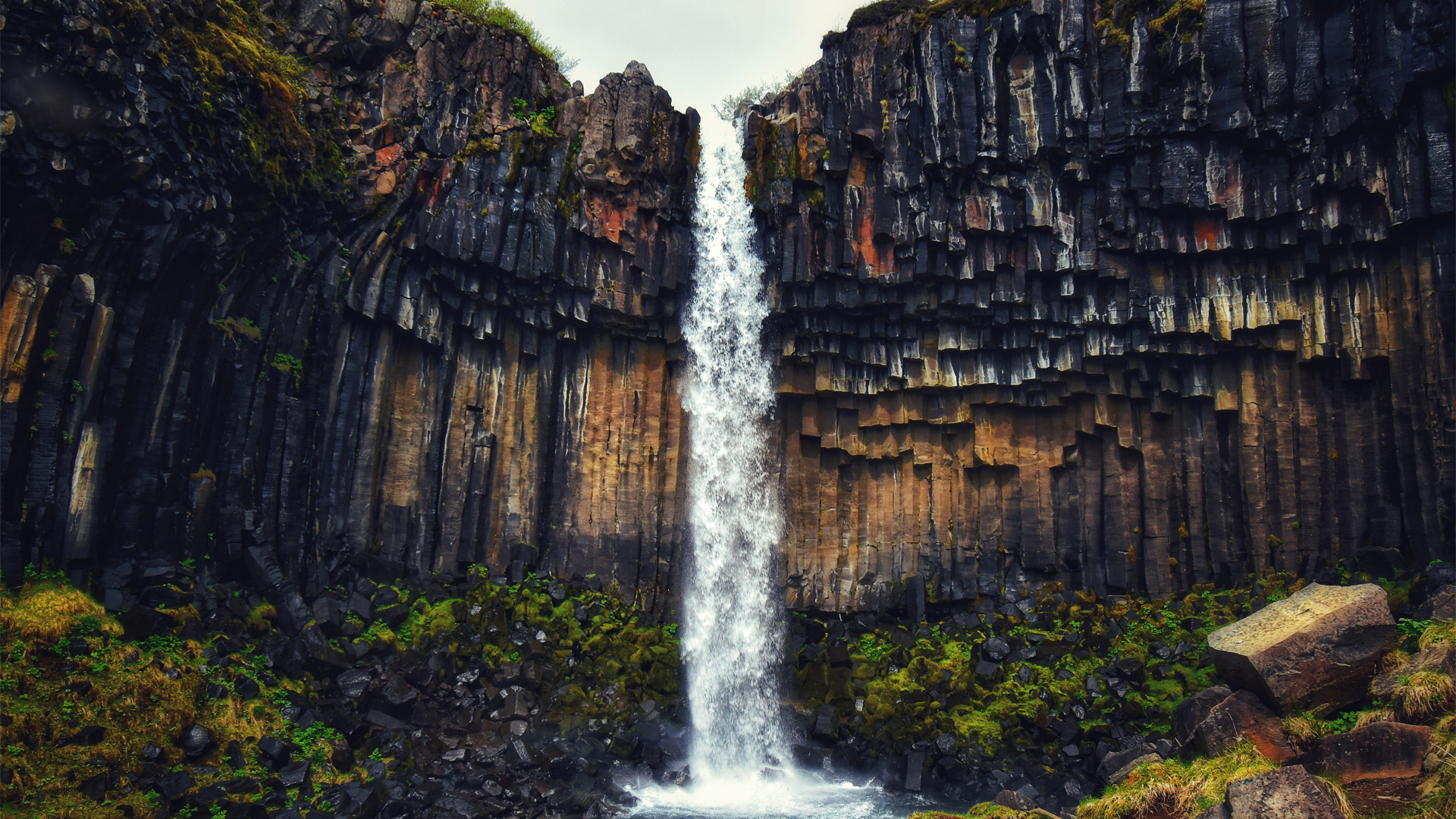
Distinctive Beauty: Located in Skaftafell Nature Reserve, Svartifoss, also known as Black Falls, is famous for its striking contrast between the white cascading water and the dark hexagonal basalt columns.
Wild Natural Scenery: The area surrounding Svartifoss is characterized by its wild beauty, including canyons, hanging valleys, and glacial rivers, offering a glimpse into Iceland’s rugged terrain.
Hiking to the Falls: The trail to Svartifoss starts from the Skaftafell visitor center, covering a 1-mile distance, and features three smaller waterfalls along the east bank. To fully experience Svartifoss, it’s recommended to take a 5.5 km round trip on a marked trail from the visitor center, ideally going up one path and down another for diverse views.
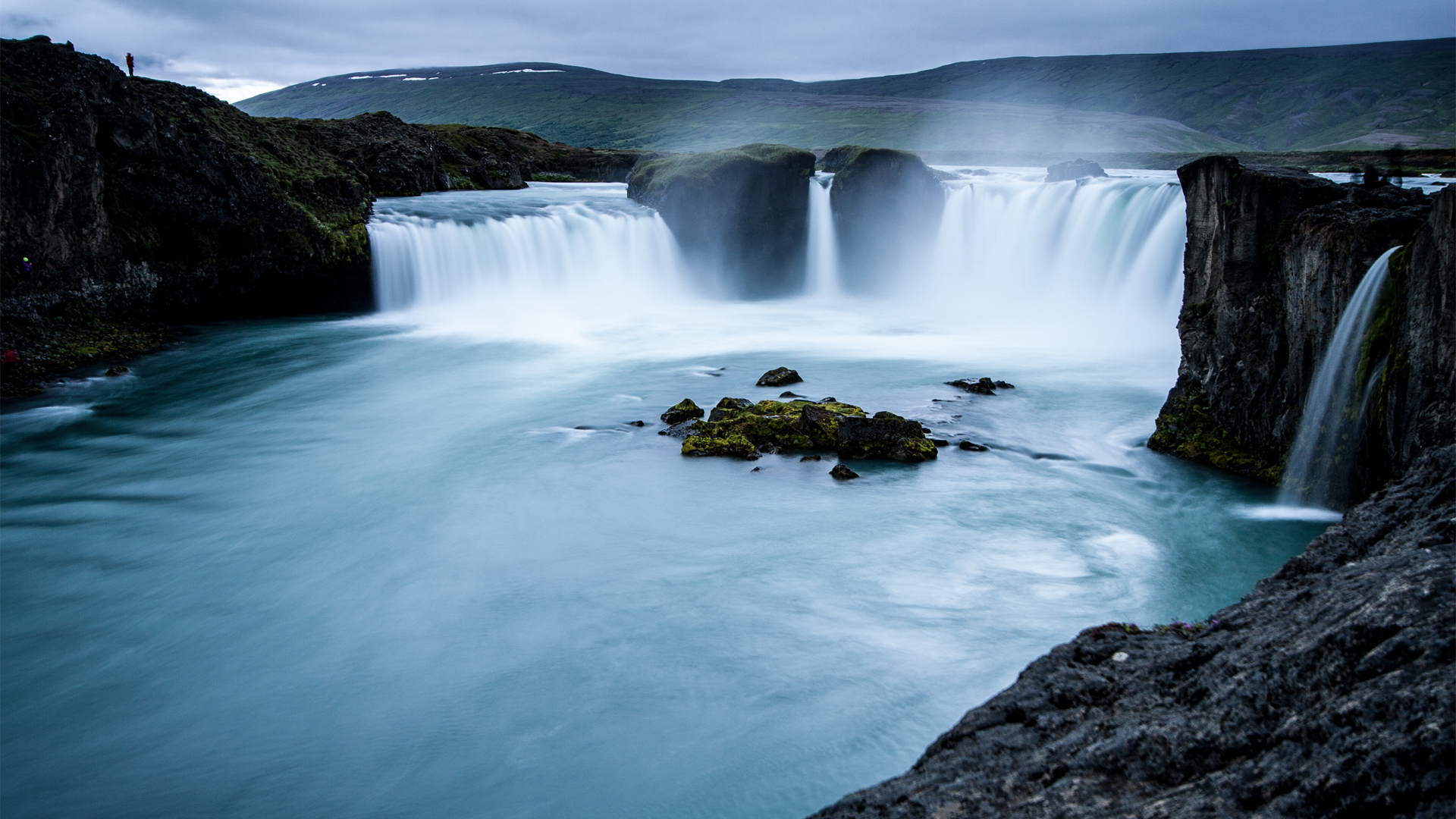
Location and Significance: Located in North Iceland, Godafoss is a horseshoe-shaped waterfall known for its grandeur and historical significance, aptly named the “waterfall of gods.”
Physical Features: The waterfall boasts an impressive width of 98 feet and a height of 12 meters, flowing into Skjalfandafljot, Iceland’s fourth-largest river.
Accessibility and Tours Reaching Godafoss: Visitors can reach Godafoss through a 9-hour tour from Akureyri or by traveling the Diamond Circle route, which includes this magnificent waterfall.
7. Dettifoss Waterfall
View Website Get Directions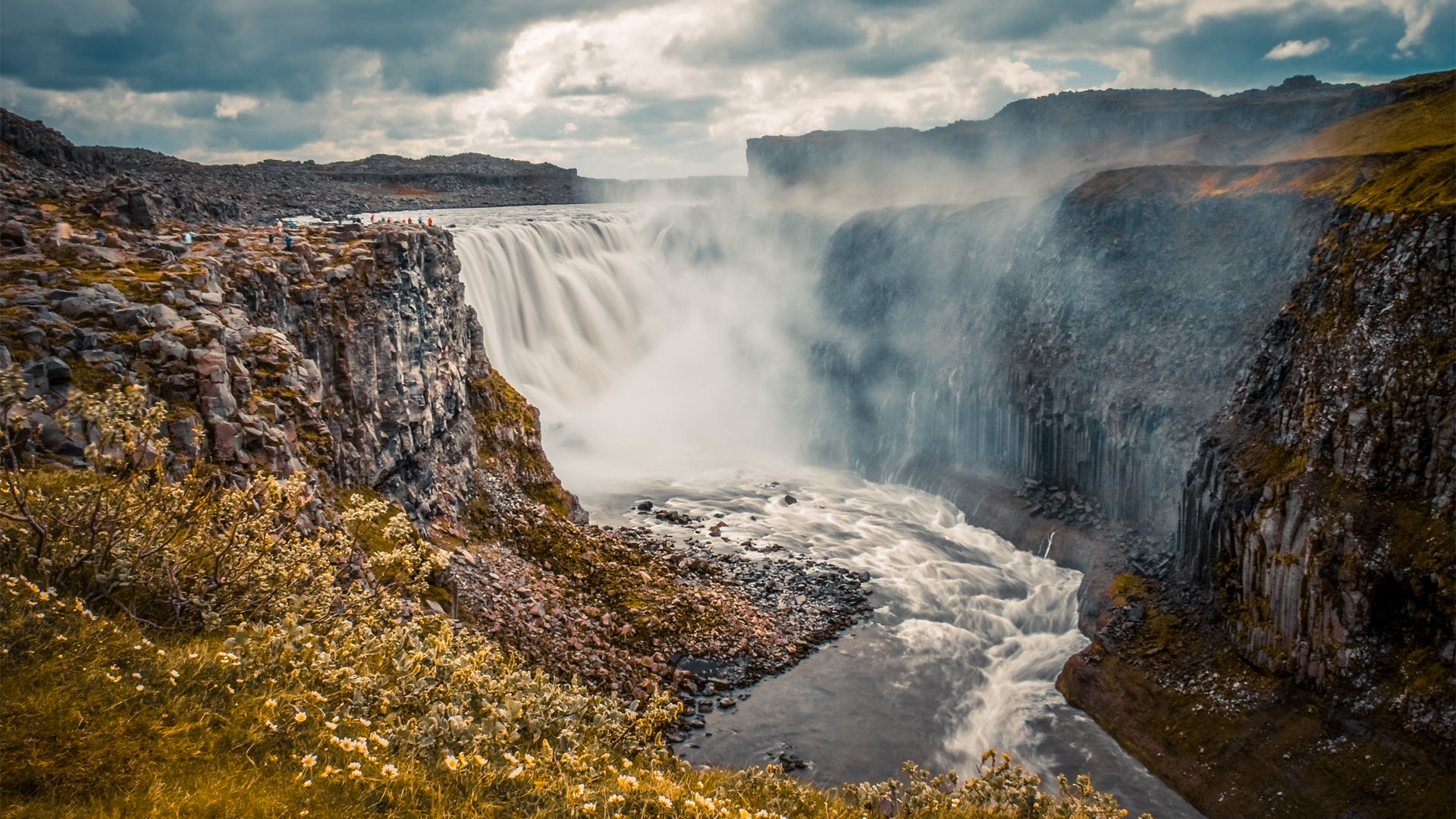
Location and Size: Situated in the Vatnajokull National Park in North Iceland, Dettifoss is an impressive waterfall, measuring 100 meters in width and a 44-meter drop. Known for its immense power, Dettifoss discharges water at a forceful rate of 200 cubic meters per second, making it a spectacular natural phenomenon.
Unique Appearance: The waterfall’s gray-white water, laden with glacial sediments, gives it a powerful and unique appearance.
Accessibility and Visitor Tips: While the waterfall is easily accessible by road, it’s important to check road conditions before visiting in winter, as they can be closed due to weather.
8. Hraunfossar Waterfall
View Website Get Directions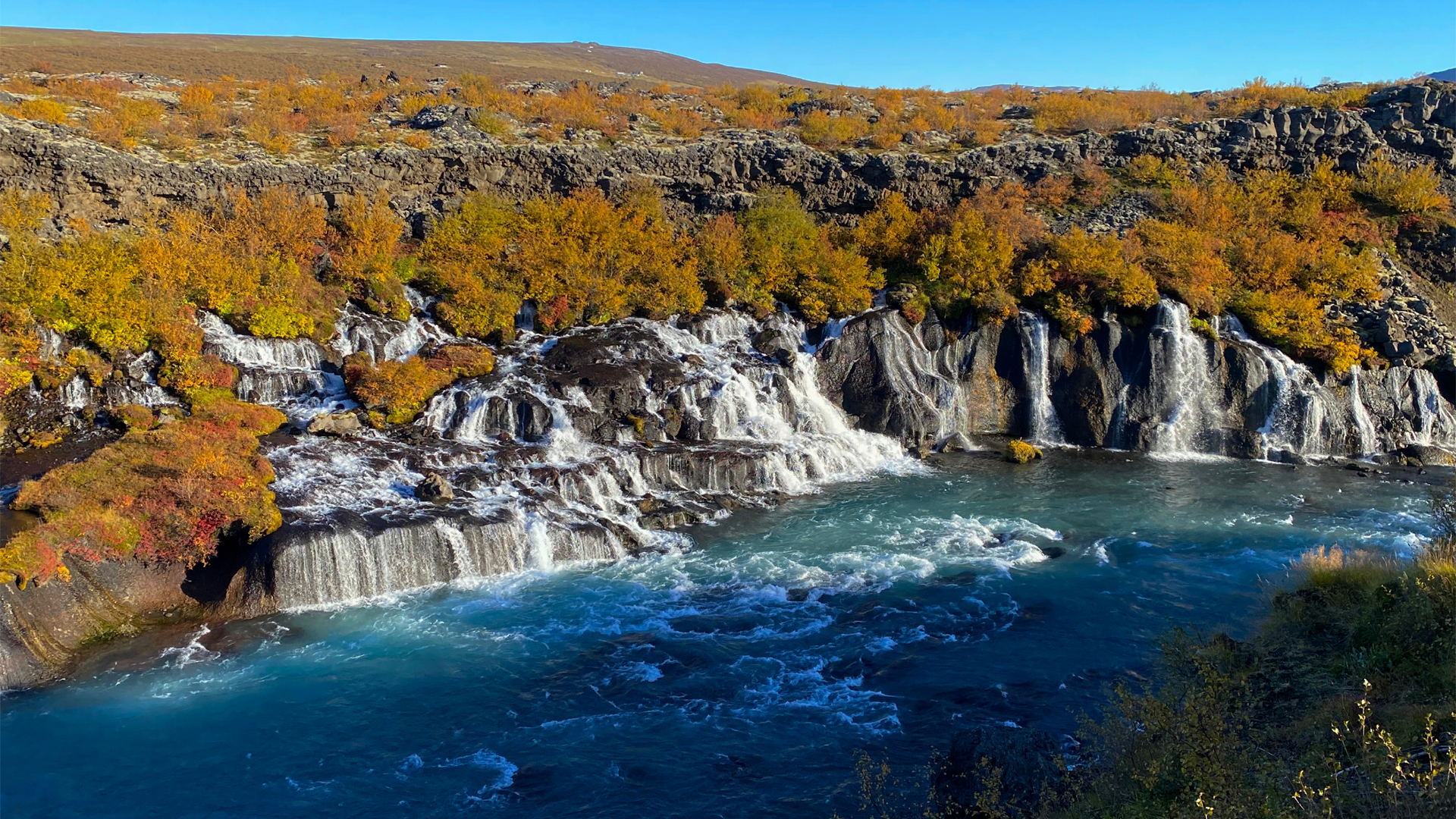
Scenic Streams and Source: Hraunfossar, located in West Iceland, is a unique waterfall composed of numerous small streams originating from Hallmundarhraun, a lava field formed from an eruption beneath Langjökull glacier.
Dynamic and Picturesque: The waterfall is characterized by its stunning beauty, with streams resembling veins running through the lava field before cascading over cliffs, spanning a remarkable 900-meter stretch.
Attractions and Activities: Hraunfossar serves as an excellent detour for travelers returning to Reykjavík, offering a chance to explore this natural wonder and the nearby Barnafoss. Visitors can also engage in an ‘Into the Glacier’ tour, which includes walking inside ice tunnels in Langjökull glacier.
9. Bruarfoss Waterfall
View Website Get Directions
Off-the-Beaten Path: Bruarfoss waterfall offers a unique, less-traveled experience in Southwest Iceland, located in the Grimsnes area along the Bruara River.
Striking Blue Waters: What sets Bruarfoss apart is not its size or power, but its remarkable blue hue, creating a mesmerizing visual experience.
Hiking Adventure: Reaching this hidden gem involves an hour’s hike on a dirt and gravel path, making it a rewarding journey for those seeking tranquility and natural beauty. En route to Bruarfoss, visitors encounter two smaller waterfalls, Hlauptungufoss and Midfoss, both featuring the same stunning aquamarine waters.
10. Dynjandi Waterfall
View Website Get Directions
Stunning Location: Situated in the remote Westfjords region of Iceland, Dynjandi Waterfall stands as a magnificent natural spectacle. Known as the “Jewel of the Westfjords,” Dynjandi impresses with its dramatic shape and size, stretching 98 feet wide at the top and 196 feet at the bottom.
Thunderous Cascade: The waterfall’s descent of 328 feet and its roaring sound, aptly translated as “Thundering,” make it a breathtaking sight. If you have got a desire to visit the breathtaking waterfalls then don’t forget to visit the Breathtaking waterfalls of North Carolina.
Hiking to the Falls: A 15-minute hike from the parking area to the fall allows visitors to explore six other waterfalls along the way. Nestled in the remote Westfjords region of Iceland, Dynjandi Waterfall is a sight to behold.
11. Gljúfursárfoss Waterfall
View Website Get Directions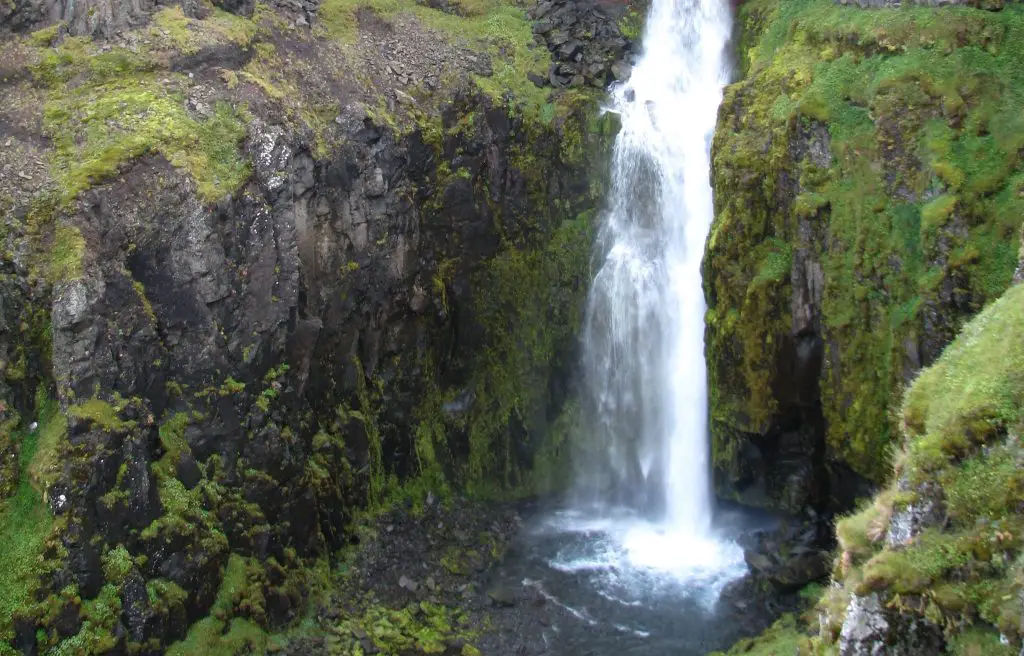
Location and Landscape: Gljúfursárfoss is a lesser-known but equally captivating waterfall located in North Iceland. It’s part of the diverse and scenic landscape that characterizes this region, offering a serene and somewhat secluded experience. This makes it a hidden gem for those who venture off the beaten path.
Visual Appeal: Its waters cascade gracefully over rocky terrain, creating a picturesque scene. This makes Gljúfursárfoss a delight for photographers and nature enthusiasts alike. The surrounding area is typically lush, adding to the tranquil ambiance of the waterfall.
Accessibility: The accessibility of Gljúfursárfoss may vary depending on the season and weather conditions. Therefore, it’s advisable to check local travel guides for the best visiting times to ensure a safe and enjoyable experience.
12. Selfoss Waterfall

Location and Characteristics: Selfoss is a remarkable waterfall located in North Iceland, near the more famous Dettifoss. It is distinguished by its broad, horseshoe-like shape. Although it’s only 11 meters high, it spans approximately 100 meters across, making it a unique feature in the Icelandic landscape.
Source and Appearance: The waterfall is part of the Jökulsá á Fjöllum river, which originates from the Vatnajökull glacier, Europe’s largest glacier. The water of Selfoss has a distinctive greyish hue, a result of the sediment it carries from the glacial melt. This aspect adds to the waterfall’s unique visual appeal.
Visitor Experience: Visiting Selfoss provides an immersive experience, with the waterfall’s wide curtain of water creating a powerful display of nature’s force. The surrounding area is rugged and raw, perfectly typifying the wild beauty of the Icelandic landscape. This makes it a must-visit spot for those seeking to experience the untamed beauty of Iceland.
13. Hafragilsfoss Waterfall
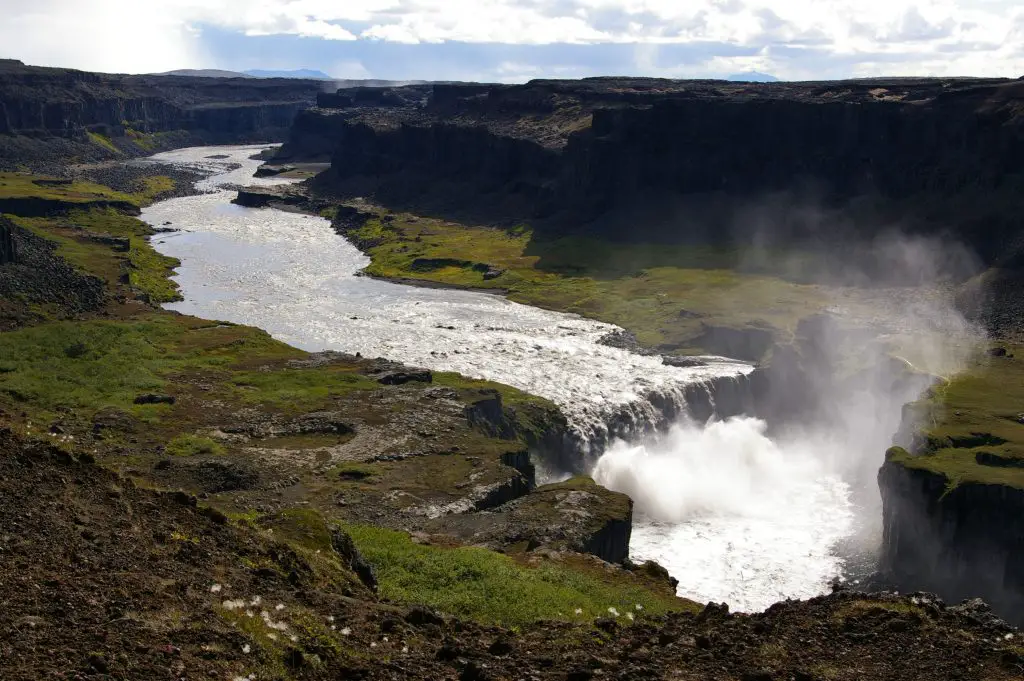
Location and Setting: Hafragilsfoss is situated further downstream from Dettifoss within the Vatnajökull National Park in North Iceland. This positioning in the park places it amidst some of the most dramatic landscapes in the country. The waterfall offers a tranquil setting, away from the crowds, for those looking to appreciate Iceland’s raw natural beauty.
Physical Attributes: The waterfall is known for its dramatic and powerful appearance, as it plunges 27 meters into the Jökulsárgljúfur canyon. The falls are 91 meters wide, making Hafragilsfoss an imposing and grand sight to behold. Its size and power are key aspects that draw visitors to this natural wonder.
Viewing Experience: One of the unique aspects of Hafragilsfoss is the impressive viewpoint that allows visitors to take in the grandeur of the falls along with the expansive canyon. The surrounding area is marked by stark, volcanic landscapes, typical of the Icelandic highlands, offering a stark contrast to the roaring white waters of the fall.
14. Aldeyjarfoss Waterfall
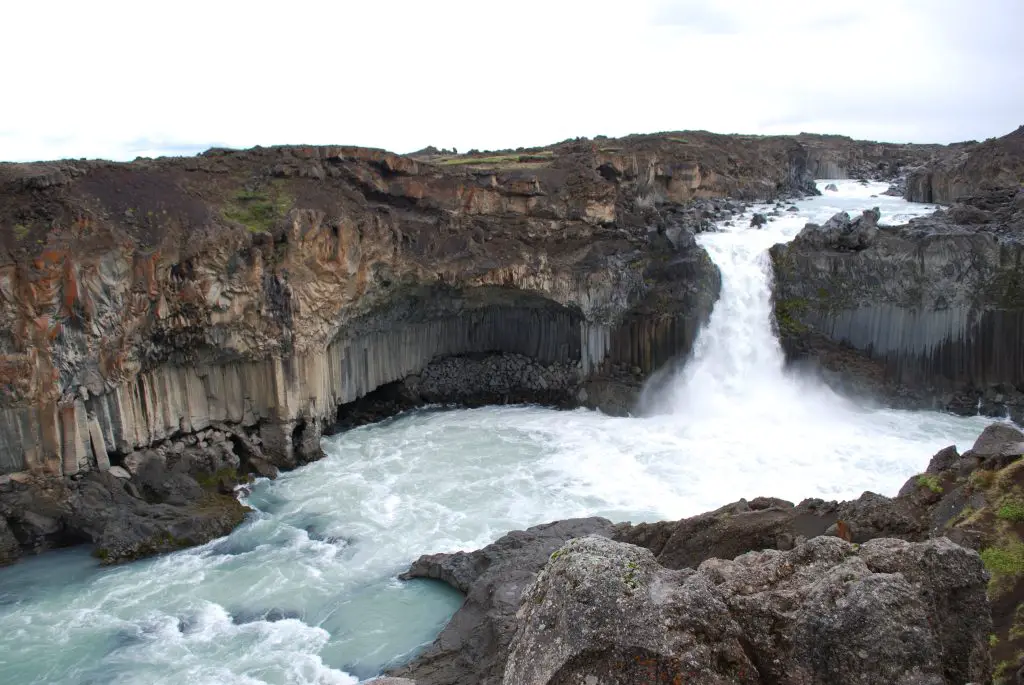
Location and Source: Aldeyjarfoss is a spectacular waterfall located in North Iceland. It is part of the Skjálfandafljót river, which originates from the Vatnajökull glacier, Europe’s largest ice cap. This location contributes to its distinct characteristics and stunning natural beauty.
Geological Features: The waterfall is renowned for its unique geological features, particularly the impressive basalt columns that surround it. These columns create a natural amphitheater-like setting, enhancing the visual appeal of Aldeyjarfoss. The dark basalt columns form a striking contrast with the white, frothing water of the waterfall.
Waterfall Characteristics: Aldeyjarfoss plunges from a height of about 20 meters into a narrow, deep pool below. This dramatic drop, combined with the surrounding basalt columns, makes Aldeyjarfoss a favorite subject for photographers.
15. Faxi Waterfall
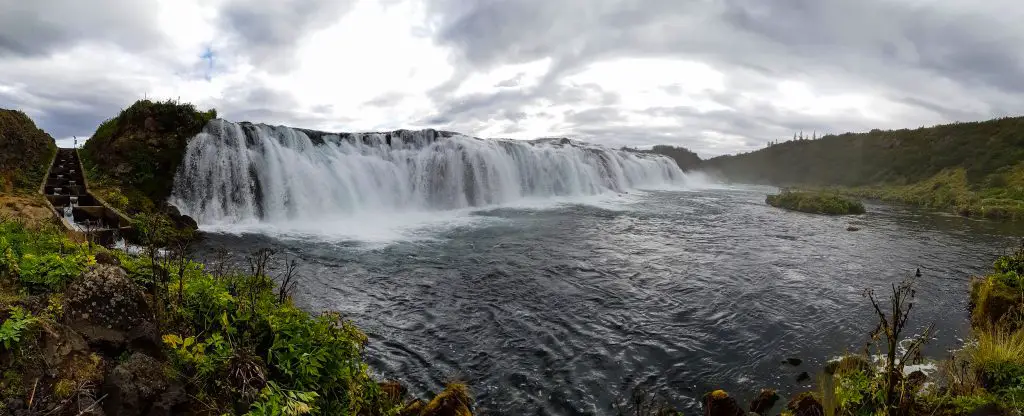
Location and River Faxi: A serene waterfall located in the southern part of Iceland. It is situated within the Golden Circle region and forms a part of the Tungufljót river. Its proximity to the more famous Gullfoss gives visitors a chance to explore a less frequented yet equally charming natural feature.
Physical Characteristics: Though Faxi is not particularly high, with a drop of only about 7 meters, its notable feature is the width, which extends nearly 80 meters. This expanse creates a gently cascading appearance, resulting in a picturesque and tranquil scene.
Surrounding Environment and Activities: The large pool at its base is a renowned spot for salmon fishing, attracting anglers looking for a peaceful fishing experience. The surrounding area, lush and green, provides a perfect setting for picnics and relaxation.
16. Foss á Síðu Waterfall

Location and Geological Background: Foss á Síðu is a picturesque waterfall located in the south of Iceland. It is uniquely positioned as it cascades over a cliff that is part of an ancient sea cliff. The waterfall, about 30 meters high, offers a glimpse into Iceland’s geological past.
Water Source and Visual Appearance: The waterfall is fed by the Dverghamrar (Dwarf Rocks) mountains, known for their fascinating formations. As the water flows over the mossy cliff face, it creates a veil-like appearance, adding to the charm and elegance of Foss á Síðu.
Accessibility and Seasonal Beauty: Foss á Síðu is easily visible from the Ring Road, making it a convenient and accessible stop for travelers exploring Iceland. The waterfall’s beauty is especially pronounced in winter when it can freeze entirely, forming an impressive icy sculpture.
17. Gluggafoss Waterfall

Unique Features: Gluggafoss, known as Window Falls, stands out for its distinctive “windows” – natural openings in the rock formations behind the waterfall. These windows are created by the water carving holes and tunnels into the cliff over time, allowing the water to cascade through them.
Structure and Location: Gluggafoss is a series of waterfalls located in southern Iceland, with the main drop measuring about 44 meters in height. It’s a part of the Merkjá river system and is nestled amidst lush greenery, contributing to a picturesque and serene landscape.
Visitor Experience: Less frequented by tourists, Gluggafoss offers a peaceful and more intimate experience compared to the more popular waterfalls in Iceland. It is especially favored by local visitors, making it a hidden gem for those looking to explore the Icelandic countryside away from the usual tourist trails.
18. Gljúfrafoss Waterfall
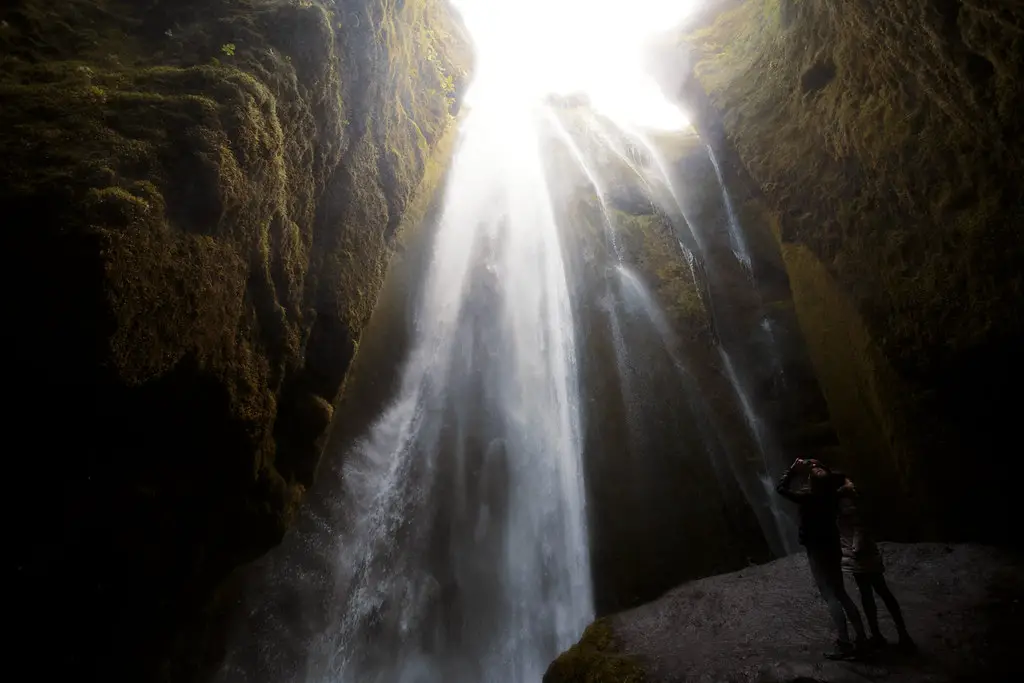
Unique Features: Gljúfrafoss is a unique and somewhat hidden waterfall in Iceland, characterized by its location where it falls into a cave over a cracked cliff. This waterfall is intriguing because it can only be fully appreciated by hiking to the top of the cliff or through hidden paths that lead into the cave, offering a view of the waterfall from below.
Dimensions and Location: The waterfall has a height of 130 feet (40 meters) and a width of about 15 feet (5 meters). It can be accessed by taking Route 1 onto Route 249 from Reykjavik.
Accessibility: To visit Gljúfrafoss, visitors can drive from Reykjavik, taking Route 1 and then turning left on Road Nr. 249. The journey takes approximately one hour and 45 minutes. A short hike into the slot canyon is required to see the waterfall up close. Visitors should be prepared for cold and wet conditions due to the mist and flowing stream in the canyon.
19. Gjáin Waterfall
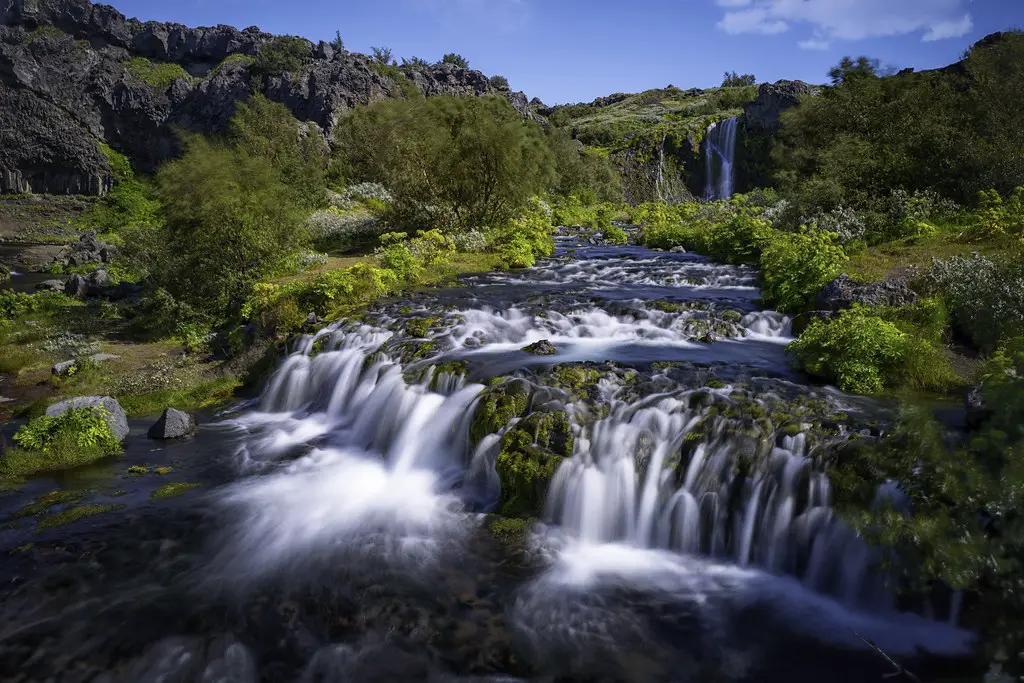
Unique Fetaures: Gjáin is a scenic valley that features an extensive collection of small waterfalls, ponds, and lava rocks. It’s often described as a ‘Garden of Eden’ due to its lush scenery and tranquil environment. The main waterfall within the valley is called Gjarfoss, known for its cascading falls into a gorge, surrounded by greenery and pools of water and lava rock.
Location: Located at the edge of the Þjórsárdalur valley near the Highlands, but still in southern Iceland, Gjáin’s remote location adds to its charm and tranquility.
Accessibility: Gjáin is around two hours away from Reykjavik by car. The journey involves traveling on Route 1, breaking off onto Road Nr. 30, then turning onto Road Nr. 32, and finally turning left onto 327 to reach the valley. A hike from the old Viking Settlement at Stong manor leads to the valley, revealing its enchanting landscape.
20. Háifoss Waterfall
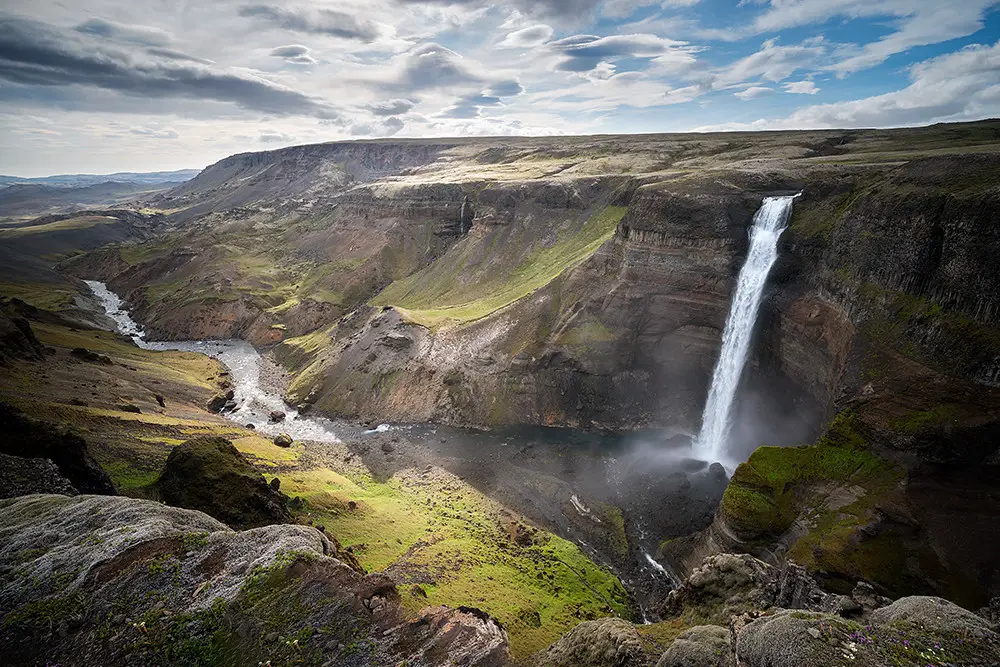
Description: Háifoss, also known as “Tall Falls” in English, is one of Iceland’s tallest waterfalls, standing at 400 feet (122 meters). It features a significant drop off a cliff into a canyon below and is fed by the Fossá River, a tributary of Þjórsá, Iceland’s longest river.
Location and Surrounding: Located near the Hekla volcano in southern Iceland, the waterfall offers stunning views of this notorious volcano, known as ‘the Gateway to Hell’ due to its frequent eruptions. Háifoss is accompanied by another waterfall, Granni, in the vicinity.
Accessibility and Folklore: Háifoss is less accessible compared to other scenic areas in Iceland. The waterfall is reachable by a combination of driving and hiking, with a historical farmstead, Þjóðveldisbærinn Stöng, serving as a starting point for hikes. The area around Háifoss is steeped in folklore, including tales of an ogress in the canyon.
21. Hjálparfoss Waterfall

Description: Hjálparfoss is an accessible and popular waterfall in Iceland, known for its beauty throughout the year. It is situated at the convergence of the Fossá and Þjórsá rivers. The waterfall is unique for its split flow, creating two waterfalls with a distinctive rock formation resembling a bear head between them.
Historical Significance: The name ‘Hjálparfoss’ translates to ‘Help Waterfall’, derived from its historical significance as a vital grazing area for horses when Icelanders traveled across the highlands.
Accessibility: Located 122 kilometers from Reykjavík, it takes approximately 1 hour and 40 minutes to reach Hjálparfoss. Visitors can drive there using Ring Road (Route 1), then take road number 30 northwards and road number 32 eastwards to reach the destination.
22. Kirkjufellsfoss Waterfall
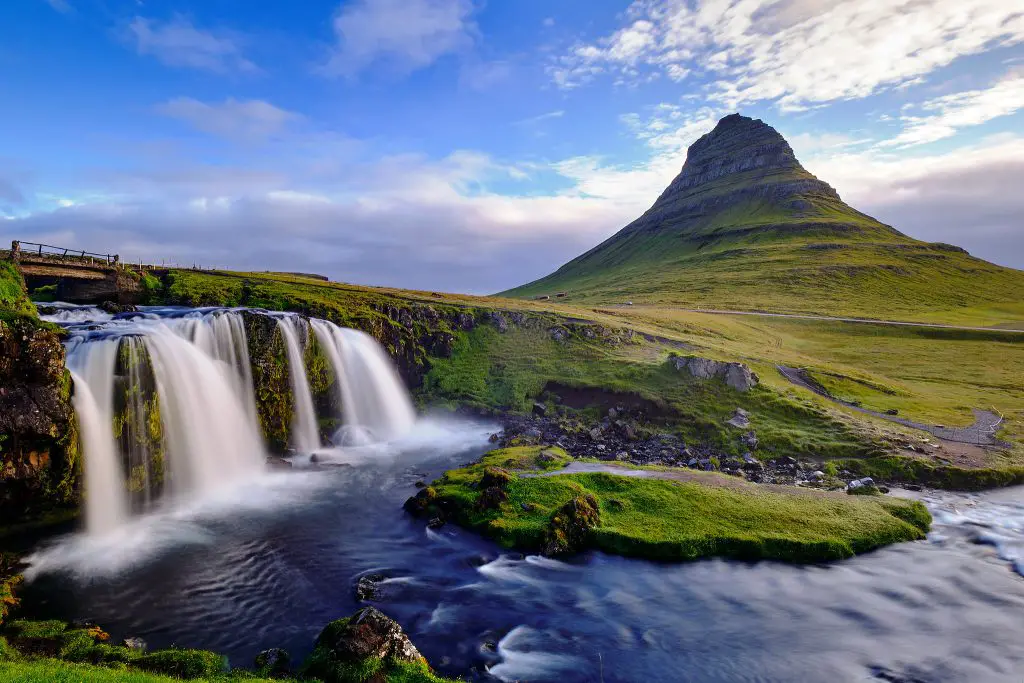
Appearance: Kirkjufellsfoss is a modest, low-lying waterfall known for its picturesque setting with the famous mountain Kirkjufell in the background. The waterfall is characterized by two broad steps, creating a tiered appearance. The upper tier drops 28 feet in two to five side-by-side plunges, while the lower tier splits into two primary channels, with one side cascading and plunging and the other plunging a sheer 26 feet.
Dimensions and Location: The total height of Kirkjufellsfoss is 54 feet. It is located on the Snaefellsnes Peninsula in Iceland, approximately 180 kilometers (110 miles) northwest of Reykjavik. The waterfall forms part of the Kirkjufellsá river, which includes three waterfalls, all named Kirkjufellsfoss.
Accessibility and Viewing Points: Kirkjufellsfoss is accessible via Route 54 on the north side of the Snæfellsnes Peninsula, about 2.5 km west of the town of Grundarfjörður. There is a parking area west of the lagoon where the waterfall is visible, and trails lead to a bridge at the top of the falls.
23. Ófærufoss Waterfall
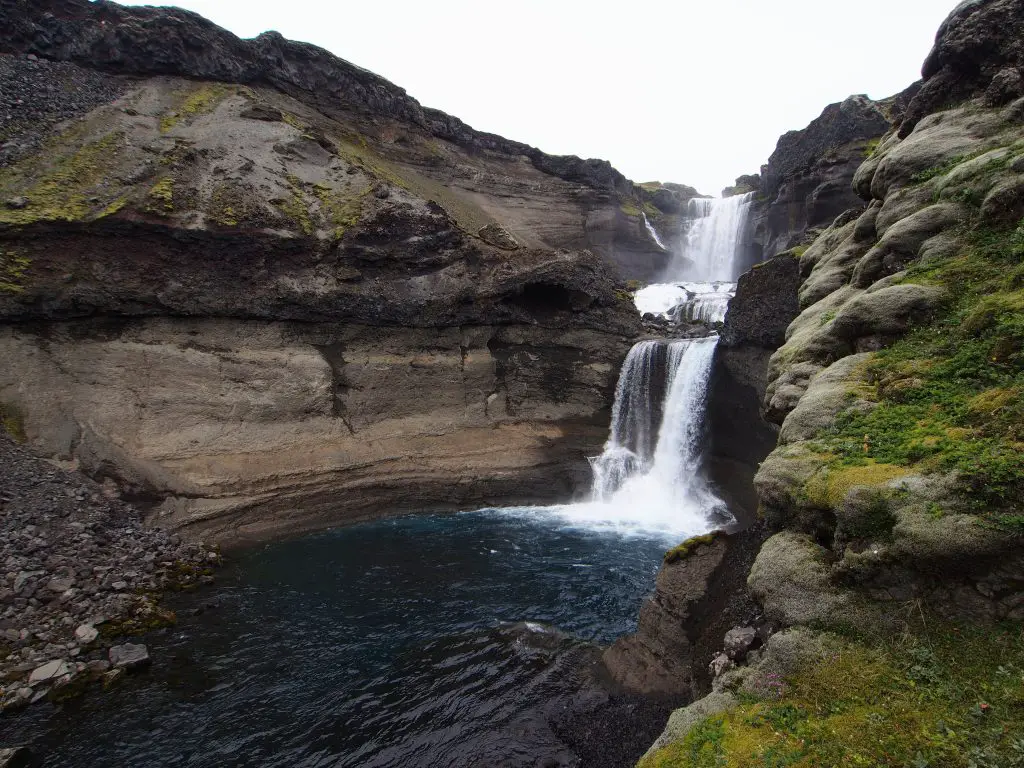
Features: Ófærufoss is a multi-drop waterfall located in the Icelandic Highlands. It falls into the Eldgjá, or the Canyon of Fire. The waterfall had a double arch over the lower cascade until 1993, when it collapsed, leaving the waterfall visually open as it falls into the fissure.
Dimensions and Location: It stands at 40 meters (130 feet) tall and has two primary drops. Ófærufoss is situated at GPS coordinates 63°57′55.8″N 18°37′07.5″W in the South Region of Iceland.
Accessibility: Access to Ófærufoss requires hiking and is only possible from July through September due to road closures in the remote area. A 4×4 vehicle is necessary for the journey. It is somewhat close to Vatnajokull National Park but outside its borders, making it less accessible for most of the year.
24. Systrafoss Waterfall
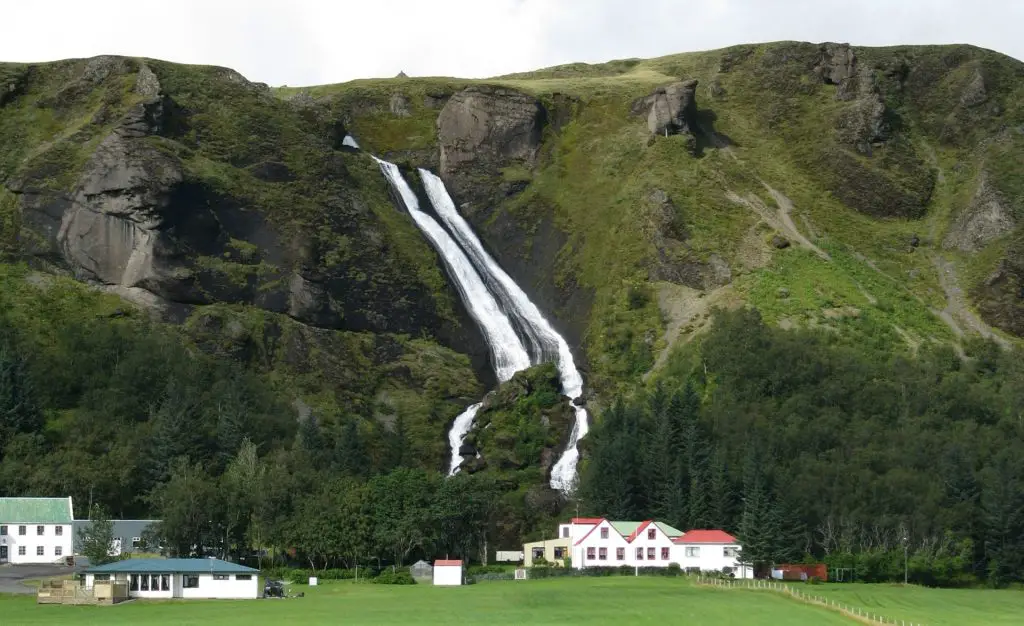
Description: Systrafoss, meaning “Sister Waterfalls,” is known for its unique appearance of two equal waterfalls falling side by side. It is located in Kirkjubæjarklaustur, in the South of Iceland. The waterfalls tumble down a slope, crashing into moss-covered boulders before flowing more chaotically.
Historical Significance: Named after a medieval monastery, the nearby lake Systravatn was believed to be the bathing place for the nuns of the monastery. The dual nature of the falls adds to its aesthetic appeal.
Accessibility and Viewpoints: Systrafoss is accessible from Vík í Mýrdal, east towards Kirkjubæjarklaustur. There’s a trail near the parking area that ascends with a fantastic viewpoint of the valley below. Visitors can also walk to the serene lake Systravatn.
25. Þjófafoss Waterfall
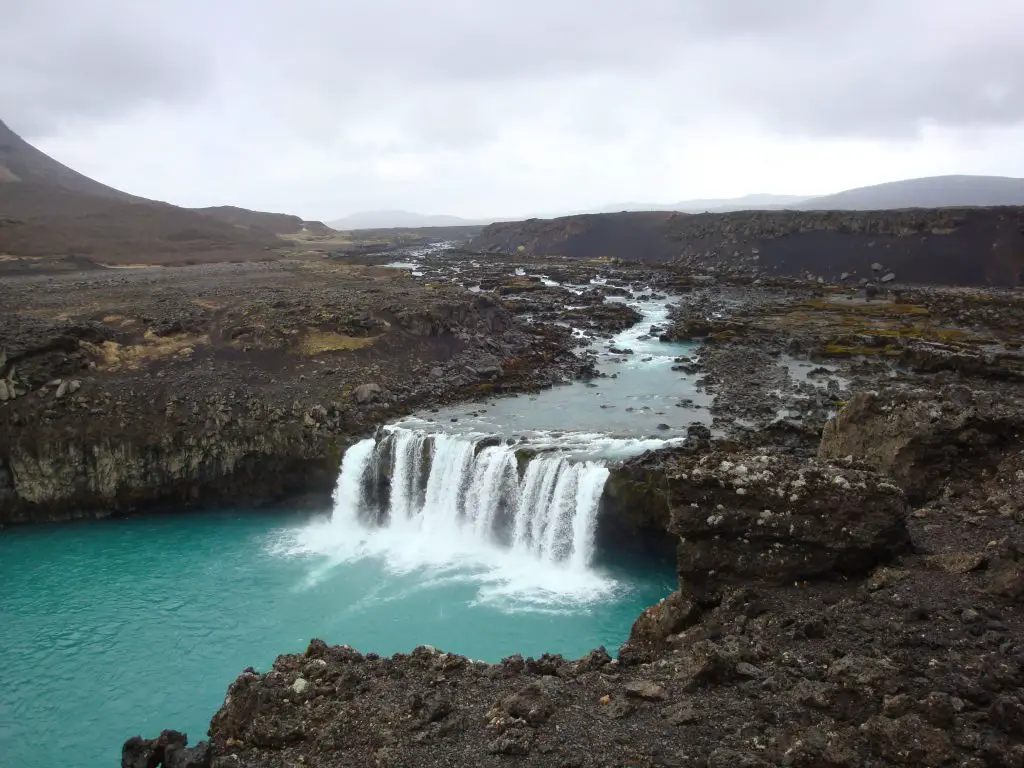
Description and History: Þjófafoss, meaning ‘thieves’ waterfall’, is one of the waterfalls on the river Þjórsá. It foams milky white at the bottom, falling beneath Mt. Burfell’s shadow. The waterfall has a dark history; it was once used for executing thieves by drowning.
Location and Activities: Þjófafoss lies in the southern region of Iceland, near the Merkurhraun lava field. It lies within Vatnajokull National Park, offering various outdoor activities like hiking, swimming, and climbing.
Accessibility and Environmental Impact: The waterfall is about four hours from Reykjavík via the Ring Road or Route 1, then Route 998. However, the waterfall’s impressiveness has diminished over the last decade due to water diversion by the nearby Búrfellsvirkjun dam.
Things to Consider Before Going to Iceland Waterfalls
Travelers who are looking for a unique and unforgettable place to visit should consider Iceland’s waterfalls. From dramatic, cascading falls to serene streams, this northern European country offers an array of impressive sights to explore. Before planning your trip, here are some things to consider:
- Weather Conditions — Iceland is known for its cold weather, so it’s important to check the forecast before heading out. Make sure you have all the necessary clothing and supplies to keep you warm and dry throughout your adventure.
- Accessibility — Many of Iceland’s waterfalls can be hard to reach, as they are located in remote areas. Consider the terrain when planning your trip – will you be able to walk or do you need a vehicle?
- Safety — Iceland’s waterfalls can be very dangerous, so make sure you are properly prepared and familiar with safety protocols before heading out. Wear the right shoes and bring extra layers in case of an unexpected storm.
- Cost — visiting Iceland’s waterfalls can be quite expensive, so make sure you plan your budget accordingly. Consider any entrance fees or tour prices when deciding how much to spend.
How Do We Pick Our Recommendations?
After visiting the enchanting waterfalls in Florida, our team arrived in Iceland. We take into account several factors when selecting our top 25 waterfalls. It includes their scenic beauty and magnitude, accessibility, safety considerations, and more. All of these elements are taken into careful consideration before making our selection. Furthermore, we also visit each of the waterfall sites to ensure that they meet our standards for a quality experience. Ultimately, we strive to provide you with an unforgettable waterfall experience in Iceland!
[wsfq]Are all the waterfalls easily accessible?[/wsfq][wsfa]While some waterfalls may be easier to access than others, most of them require a bit of effort to get to as they are hidden away in the countryside or volcanic mountains.[/wsfa]
[wsfq]What kind of activities can I do at the waterfalls?[/wsfq][wsfa]You can take part in a variety of activities, including sightseeing and photography, hiking, swimming, kayaking, and more.[/wsfa]





